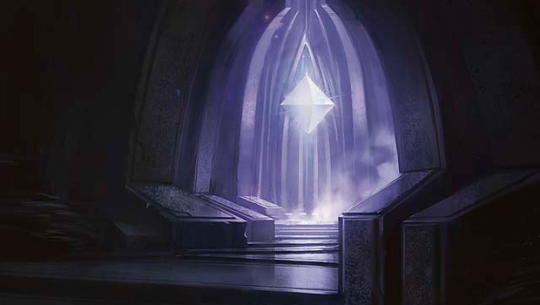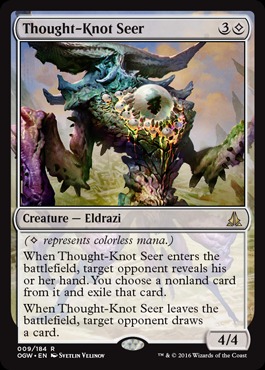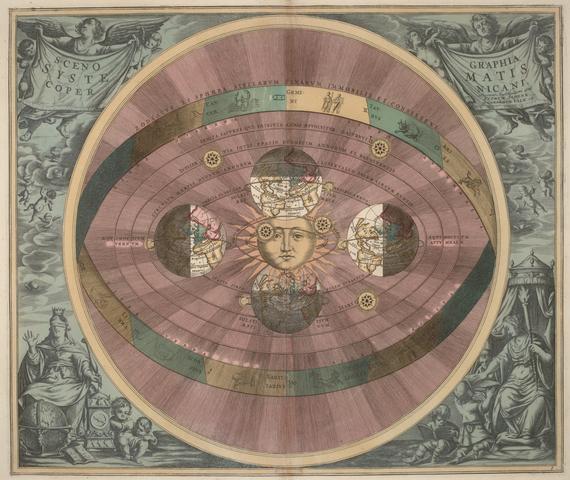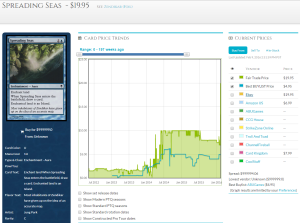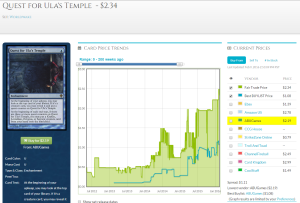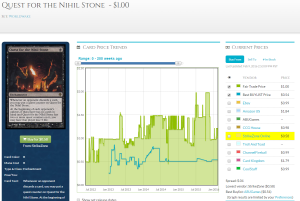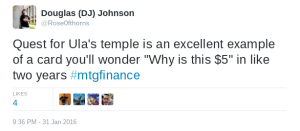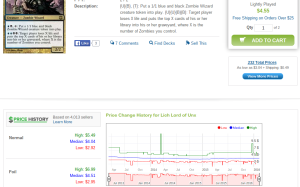We are just a few days away now from what will become a major turning point in Modern Magic’s history. For the past three months we’ve been living in “Eldrazi Winter,” and as much as I don’t love naming every period in Magic “winter” — a reference to the “combo winter” of old — it’s hard to argue that the term doesn’t apply to where Modern has existed since the release of Oath of the Gatewatch.
The Eldrazi decks, starting with the colorless and blue-red versions that took the Pro Tour by storm, quickly became dominant in Modern, a format ripe for the picking after the ban of Splinter Twin and Summer Bloom left it without some of its former pillars. No matter how you feel about those bans, there’s no question that Pro Tour Oath of the Gatewatch was a wide-open affair, and a wide variety of decks showed up for the event.
Unfortunately, none of those decks could stand up to Eldrazi. As our tentacled overlords began to lay waste to the format around them, it became increasingly important to not just have a plan to beat the rest of the format, but to have a plan for the mirror. After all, as deck after deck tried and failed to down the Eldrazi menace, planning for the mirror became the most defining part of any given Eldrazi deck, whether it was colorless, blue-red, red-green or the omnipotent white-blue versions.
As the format tried and failed to push out Eldrazi, the calls for a ban heated up. When the triple-Grand Prix weekend of Melbourne, Bologna and Detroit saw five of the six Finals deck turn out to be White-Blue Eldrazi — and with the deck making up more than 40% of the Top 100 Day 1 decks at all three events and winning on Day 2 at a percentage rate similar to Standard CawBlade pre-ban — the writing was on the wall, and a post-event interview with Aaron Forsythe all but confirmed changes would be coming in the form of a banlist update.
Thus led to the next great debate, and the topic of today’s article: what piece will be banned?
Before I go any further, I want to make a few disclosures. First, I have no inside knowledge of what will be banned, and though I am fairly confident in my ability to read Wizards’ tendencies with bans there is no guarantee of what they will do.
It’s also worth noting that I’ve been on record since the very beginning stating Eye of Ugin should be banned. Long before the Pro Tour or any inkling of the actual decklists to come, I believed Eye of Ugin would become too unhealthy for the format to be allowed to exist, and you can hear my reasoning then during a guest appearance on the podcast Masters of Modern. This earned me the designation of “town crier” during an interview with BDM during GP Detroit coverage, but considering the fallout from Eldrazi it’s a title I’ll wear proudly in this circumstance.
Why Eye will be Banned
It’s Unhealthy
Now the argument about the “health” of a card is something that can go miles deep. After all, “health” and “power level” don’t always go hand in hand, though they often do.
Consider, though, Simian Spirit Guide, another card oft-talked about in regards to bans. It’s not like the card is too “powerful” on its own. While something like Jace, the Mind Sculptor is on the banlist because of how game-impacting it is on its own, Simian Spirit Guide is the opposite. Unless your plan is to beat down with an overcosted 2/2, it actually doesn’t do anything by itself. It’s rarely in “very good” decks, much less oppressive ones, so there’s no argument for it being too powerful as a card.
But is Simian Spirit Guide “healthy?” Without derailing the topic of today’s article too much, I consider this the post child of “unhealthy” based on a simple criteria: Does this card further strategies that improve the play experience for a reasonable amount of Magic players? In the case of Spirit Guide, it does nothing but turn a Turn 3 deck into a Turn 2 deck in the vast majority of archetypes it sees play in. In this sense, it’s incredibly binary — it’s either incredibly good, or laughably bad, and I would argue this does not improve the average play experience. While I’m not making an argument today to ban Guide, I do believe it exemplifies many of the qualities that make a card unhealthy in a given metagame.
Eye of Ugin falls too far on the “unhealthy” side for me, though not terribly far from center. The card is very binary in all senses — it either is the best card in your hand or the worst, depending on how many copies you draw. You either play it with Eldrazi or it does nothing. There’s really no in-between with Eye, and feast-or-famine is not a particular healthy way to play games.
It is Ridiculously High Variance
This is a natural progression of the “health” argument, so consider for a moment the following card.
Variance Incarnate
Instant
1
Flip a coin. On heads, you win the game. On tails, you lose the game.
This is a “fair” card, Krark’s Thumb notwithstanding. After all, since you win or lose exactly half of the time on average, it’s the epitome of balanced. But is that amount of variance something you consider enjoyable when you sit down for a match of Magic?
Eye of Ugin cuts too close to that extreme. If it’s in your opening hand and you have the famed Eldrazi Mimic-into-Reality Smasher start, you’re going to win an extremely high percentage of your games. On the other, plenty of people have made the argument that because it’s bad in multiples certain hands and draws become “auto-lose” because you drew too many copies of your Legendary land.
Again, in theory this can be balanced (even if it hasn’t been in practice). If the draws where you have the dream are offset by the draws where you lose to drawing too many copies, you can have a deck that isn’t “too powerful” for Modern.
But, again, I’ll ask: is that how you want to play Magic?
It creates more mana than any other card in Modern
Legacy is a high-power format where there are multiple lands like Ancient Tomb and City of Traitors that exist as “sol” lands to provide more than a single mana a turn. In that context, Eye seems fair.
Modern is not that. This is a format where mana — the thing that hall of famer Zvi Mowshowitz said is always the place to start with a format — has been tightly controlled. Seething Song is banned. Rite of Flame is banned. Chrome Mox is banned. Cloudpost is banned. Summer Bloom is banned.
In a given game in the Eldrazi deck, Eye makes more mana than any of those (with the possible exception of Cloudpost). Any hand containing Eye and multiple Eldrazi Mimics or Endless Ones represents 4-6 mana all in the neat little package of one land drop, not even counting the interaction with Urborg, Tomb of Yawgmoth that allows Eye to actually produce three mana for an Eldrazi. That’s simply playing a different game than the other decks have access to.
I’ll just let PV handle this one
@Chosler88 also I think a card shouldn’t be the best thing to do on turn 1 and then also the best thing to do on turn 8.
— Paulo Vitor (@PVDDR) March 28, 2016
That pretty much nails it. There’s nothing wrong with explosive starts; after all, decks like Goblins can kill as early as Turn 3, but that explosiveness is supposed to come with a tradeoff. Fast starts are often punished by weak lategames — there’s nothing as bad as drawing Llanowar Elves or Frenzied Goblin off the top when you really need a card that does something powerful.
Eye not only dodges this problem; it completely inverts it. Not only do Eldrazi players root for an Eye of Ugin in their opening hand, they root to either draw it on Turn 8 if they don’t have one, or to draw the lands that allow them to activate. It gets the best of both worlds in a way that no other deck in Modern does, and that’s a role that nothing but Eye of Ugin can fill. When a card simultaneously allows access to both the most explosive starts and the most conisistent lategame, we have a problem.
Banning Eye helps Control emerge
This may one of the more contentious points I’ll make in this article, but it’s one I truly believe after playing thousands of matches of Modern over the last few years.
Eye of Ugin is a big part of the reason traditional control decks don’t exist.
I know people like to point to the absence of Force of Will and Counterspell — and the lack of Force especially does have an impact — but it’s one that can be handled. Mana Leak and Remand aren’t Counterspell, but they aren’t bad, either. We have seen, at times, control decks like Jeskai or traditional white-blue pop up and have success, but those times are few and far between.
A major reason? Eye of Ugin takes the traditional domain of the Control deck — the late game — and gives that power to the Eye player. Eldrazi decks can spam out huge amounts of power early in the game thanks to Eye – that’s something Control can plan for. Eye can provide a stream consistent threats late game – that’s something Control can plan for.
But it can’t plan for both. And you can’t build a Control deck that can reliably beat a Turn 3 Karn Liberated while also beating neverending Ulamog, the Ceaseless Hunger or an untouchable Emrakul, the Aeons Torn in the late game.
Yes, I’m talking about Tron. A lot of people have pointed to its use of Eye of Ugin as a reason Eye won’t be banned, but the truth is Tron’s use of Eye of Ugin has been suppressing Control in deckbuilding for a very long time. The fact that the Turn 3 Karn deck will have a worse lategame after an Eye of Ugin banning is a feature, not a bug.
They Always ban the Engine
They banned Birthing Pod, not Kitchen Finks. They banned Second Sunrise, not one of the eggs. They banned Cloudpost, not Emrakul or Vesuva. They banned Hypergenesis, not Violent Outburst. They banned Splinter Twin, not Deceiver Exarch. They banned Stoneforge Mystic, not Batterskull.
I could take the analogy back to other formats, and the trend would continue. They always ban the engine that makes a “broken” deck run, not a cog in that engine. While you could ban Eldrazi Mimic or Thought-Knot Seer, those are simply the beneficiaries of the engine that is Eye of Ugin.
What it Won’t Be
I hope you’ll agree I’ve made the case why Eye of Ugin specifically should be banned, not simply claimed it was the only option. Of course, other people feel that something else should go, name Eldrazi Temple or even something else. I want to touch briefly on these other options.
Eldrazi Temple
This is the big one people have claimed should go before Eye. After all, Eye loses its wielder some games if too many are drawn, and doesn’t help cast big threats as much as multiple Eldrazi Temple do.
While this would certainly power down the deck quite a bit — possibly even moreso than an Eye of Ugin banning — I don’t believe this is the correct answer, and it goes back to the bit on the “health” of a given card. Yes, Temple may be powerful in the Eldrazi decks, but is also more healthy than Eye.
Think about it. Eye of Ugin has this huge variance attached to it; sometimes it creates six mana on Turn 1, and sometimes it loses games when you draw multiples. If Temple is banned — which may or may not be enough to “kill” the deck, which is beside the point anyway — the Eldraiz decks will become even more dependent on that Eye of Ugin variance, just hoping to draw the perfect opening hands all day long and being heavily rewarded when they do so and heavily punished when they don’t.
Contrast this with Eldrazi Temple. It does the exact same thing every time it is cast, and will never make more than two mana the turn it is played. This increases interaction, since things like Ghost Quarter actually can interact with the times where the card would represent more than two mana over the course of the game. Eye of Ugin, on the other hand, can come down on Turn 1 and immediately spew out 4-6 mana worth of creatures before the opponent can interact. Decks can plan around Eldrazi Temple and its one-mana boost to Eldrazi, whereas it’s much more difficult to plan for a deck that sometimes makes 4-6 mana on the first turn. The goal of any healthy format is meaningful interaction, and Eldrazi Temple encourages that interaction over several turns. Eye of Ugin does not.
Anything else
Banning Eldrazi Mimic or Thought-Knot Seer or Reality Smasher to hurt Eldrazi is like banning Boros Garrison to hurt Amulet Bloom: it may work to lower the power level, but it doesn’t address the root problem (For those who don’t realize it, Amulet Bloom can’t have its nut Slayers’ Stronghold combo without Boros Garrison). Why treat the symptoms instead of the disease?
From a larger game design standpoint, making decisions like this actually sets a dangerous precedent. What happens when you ban one of the peripheral pieces to lower the power level of a deck (say, Deceiver Exarch), and then the deck finds a way to fill the hole and picks up right back where it left off? While this won’t happen every time if you take this approach, it will happen some of the time, and then Wizards is in the unenviable position of having to go back and try again to fix the problem. Imagine if Exarch had been banned but Twin simply adapted to play Bounding Krasis and kept plugging right along? Given their goals with that banning, Wizards would have had to go back and ban another piece, or possibly Splinter Twin itself. And if Splinter Twin eventually ends up on the banlist, why does Deceiver Exarch belong there? Do they then unban Exarch?
That’s a lot of uncertainty that undermines consumer confidence, and is entirely avoidable simply by peeling the band-aid off at once and getting it over with. It’s also why they banned Dig Through Time alongside Treasure Cruise. Sure, most Modern decks weren’t exactly jamming Dig very much, but what if they just replaced Cruise with Dig after the ban and kept warping the format? Then you have players who thought the bannings were over with get punished a second time around when Wizards makes another run back at the deck.
That’s why you’re not going to see them tip-toe around with this one. The Eldrazi decks needs to be trimmed, and Eye of Ugin and possibly Eldrazi Temple alongside it are going to banned to do that.
And then the Modern world opens wide for us to explore.
Thanks for reading,
Corbin Hosler
@Chosler88 on Twitter/Twitch/Youtube
